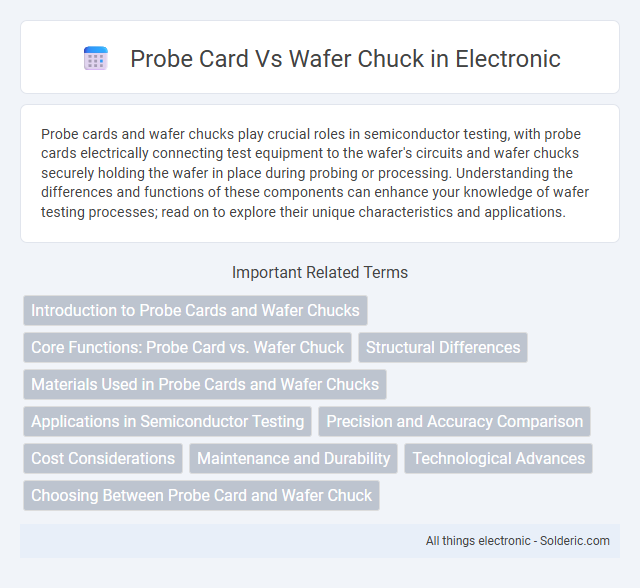Probe cards and wafer chucks play crucial roles in semiconductor testing, with probe cards electrically connecting test equipment to the wafer's circuits and wafer chucks securely holding the wafer in place during probing or processing. Understanding the differences and functions of these components can enhance your knowledge of wafer testing processes; read on to explore their unique characteristics and applications.
Comparison Table
| Feature | Probe Card | Wafer Chuck |
|---|---|---|
| Purpose | Connects semiconductor tester to wafer for electrical testing | Holds wafer securely during testing or processing |
| Function | Establishes precise electrical contact with wafer pads | Maintains wafer position and flatness |
| Location | Attached to test equipment, contacts wafer surface | Mounted on prober chuck station, supports wafer bottom |
| Component Type | Electrical interface device with probes | Mechanical fixture with vacuum or electrostatic chuck |
| Material | Metal probes, ceramic or composite substrates | Metal, ceramic, often with vacuum or electrostatic elements |
| Role in Testing | Enables electrical signal measurements on dies | Secures wafer to prevent movement during probing |
| Typical Usage | Wafer sort testing during semiconductor manufacturing | Wafer handling and positioning in probe stations |
Introduction to Probe Cards and Wafer Chucks
Probe cards serve as critical interfaces that connect semiconductor test equipment to individual dies on a wafer, enabling precise electrical testing during semiconductor manufacturing. Wafer chucks securely hold the wafer in place on the testing platform, ensuring stability and accuracy throughout the probing process. Understanding the distinct roles of probe cards and wafer chucks helps optimize your semiconductor testing workflow for improved device quality and yield.
Core Functions: Probe Card vs. Wafer Chuck
Probe cards serve as critical interfaces in semiconductor testing, facilitating electrical contact between test equipment and semiconductor wafers to evaluate integrated circuit functionality. Wafer chucks focus on securely holding the wafer in place during processing or testing, ensuring precise alignment and stable positioning to prevent damage or misalignment. Both components are essential in semiconductor manufacturing, with probe cards enabling signal transmission for testing and wafer chucks providing mechanical support and accurate wafer positioning.
Structural Differences
Probe cards consist of an array of microscopic needles or probes aligned precisely to contact the pads of a semiconductor wafer for electrical testing. Wafer chucks, on the other hand, are flat, rigid platforms designed to securely hold the wafer in place during manufacturing processes, often using vacuum suction or electrostatic force. Your understanding of the structural differences highlights that probe cards are intricate contact tools, while wafer chucks serve as stable mechanical supports.
Materials Used in Probe Cards and Wafer Chucks
Probe cards typically feature materials such as beryllium copper for probe pins due to its excellent conductivity and spring properties, combined with ceramic or organic substrates for insulation and structural support. Wafer chucks commonly use materials like aluminum or stainless steel for the base, enhanced with vacuum grooves or electrostatic adsorption surfaces made from polymers or coated ceramics to securely hold the wafer during testing. The choice of materials in both probe cards and wafer chucks directly impacts thermal stability, electrical performance, and mechanical reliability in semiconductor testing processes.
Applications in Semiconductor Testing
Probe cards and wafer chucks play crucial roles in semiconductor testing, with probe cards enabling precise electrical contact to test integrated circuits on wafers, while wafer chucks securely hold wafers during inspection and probing. Probe cards are essential for functional testing of individual dies, ensuring device performance meets specifications, whereas wafer chucks maintain wafer stability under various thermal and mechanical conditions during test procedures. Your semiconductor testing setup benefits from optimal integration of both components to ensure accurate, reliable, and efficient quality control.
Precision and Accuracy Comparison
Probe cards provide high precision in making electrical contact with semiconductor wafers during testing, ensuring accurate signal transmission to individual die sites. Wafer chucks offer superior mechanical stability by firmly holding wafers in place, minimizing positional deviations and enhancing accuracy during probe alignment. Combining probe cards with wafer chucks optimizes overall testing precision by merging accurate electrical interfacing with consistent wafer positioning.
Cost Considerations
Probe cards generally incur higher upfront costs due to their intricate design and the need for precise alignment with semiconductor wafers, impacting your initial testing budget. Wafer chucks, being simpler mechanical devices, typically offer lower manufacturing and maintenance expenses, providing cost-effective solutions for wafer handling and positioning. Evaluating your production volume and testing accuracy requirements will help balance the cost-benefit ratio between investing in probe cards versus wafer chucks.
Maintenance and Durability
Probe cards require regular maintenance to ensure precise contact with semiconductor wafers, as their delicate needles can wear or become misaligned, impacting test accuracy. Wafer chucks, designed for stability and endurance, typically demand less frequent maintenance but must be checked periodically for surface contamination or damage to maintain wafer adhesion and temperature control. Your choice between the two should consider the balance of maintenance frequency and durability requirements for optimizing production uptime.
Technological Advances
Technological advances in probe cards include the integration of high-density contact arrays and micro-electromechanical systems (MEMS) to enhance signal integrity and minimize damage to semiconductor wafers during testing. Wafer chucks have seen innovations such as electrostatic and vacuum clamping technologies combined with advanced temperature control systems to ensure precise wafer positioning and uniform thermal management. Both probe cards and wafer chucks benefit from improvements in materials and fabrication methods, enabling higher testing accuracy and throughput in semiconductor manufacturing.
Choosing Between Probe Card and Wafer Chuck
Choosing between a probe card and wafer chuck depends on your semiconductor testing requirements, as probe cards provide precision electrical contact for individual dies, enhancing signal accuracy during wafer sorting. Wafer chucks offer stable mechanical support and uniform thermal control, critical for processes needing minimal wafer movement and temperature consistency. Selecting the optimal tool ensures improved test throughput, accuracy, and yield in semiconductor manufacturing.
Probe card vs Wafer chuck Infographic

 solderic.com
solderic.com